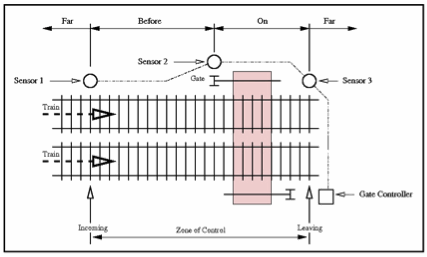
 ENPM 643/ENSE 623 Projects, Fall Semester, 2010
ENPM 643/ENSE 623 Projects, Fall Semester, 2010
[ Project 1 ]: Two-Track Railroad Crossing Problem
[ Project 2 ]: Eco-Industrial Parks
[ Project 3 ]: Two-Runway Airport
[ Project 4 ]: Modeling the Solar System through Systems Engineering
[ Project 5 ]: Innovation Proposal for SPAWAR
[ Project 6 ]: Autonomous Cars
[ Project 7 ]: Compound Failures in Submarines
[ Project 8 ]: Sensors in Sports Equipment and Clothing
Class presentations will be on November 30 and December 7.
Please make every effort to attend class on both evenings.
Don't worry if your project isn't complete -- just talk about your main
ideas, what you are hoping to accomplish and the method.
Plan for 20 minutes + 10 minutes of questions/discussion.
The purpose is to share ideas and receive constructive feedback.
Title: Two-Track Railroad Crossing Problem
Authors: Tri Van, Obafemi Somide, Ebenezer Akinpetide
Abstract: Our project will consider a two-track railroad crossing system where sensors would be used to control the opening and closing of gates to control the flow of traffic across the railroad crossing.

Through the use of modeling design techniques, we will abstract out and analyze the system behaviors of a two-track railroad crossing system in order to properly validate and verify that our system operates within desired system boundaries and conditions.
This model can then serve as a template for solving similar two-track railroad crossing problems.
Class Presentation: Scheduled for December X.
Title: Eco-Industrial Parks
Author: Kyu Sung Jang andThuy-Lien Vu Briggs
Abstract: An eco-industrial park is a large industrial complex where several well-sized firms (manufacturing, power production, textiles, chemical production, etc.) co-locate with the intention of exchanging residual byproducts from their industrial processes, sharing/cascading of common utilities like water, heating, and electricity.
This project will detail out validation and verification steps for eco-industrial parks from a system of systems perspective, where the entire park as the main system, the tenants involved act as the subsystems, and the water, electricity, and/or materials exchanged between tenants can act as the components of each individual subsystem. We intend to investigate a real-world U.S. eco-industrial park, but consideration as to which one is still being taken.
Class Presentation: Scheduled for December X.
Title: Two-Runway Airport
Author: Clayton Cruppenink and Edwin Fernandes
Abstract: Our project will center on the verification and validation of an airport airside consisting of multiple runways and an air traffic control tower. The control tower will direct the incoming and outgoing flights allowing multiple flights to liftoff and/or land at the same time.
For this project we will look at the entire airside of the airport as a system with the planes and control tower acting as components within the system.
Class Presentation: Scheduled for December 7.
Title: Modeling the Solar System through Systems Engineering
Authors: Kayla Gaydosh and David Giordani
Abstract: Our project will be a continuation of last semesters project with an emphasis on creating a mission plan for other engineers and scientists to use. These models will allow for verification and validation for space-bound programs.
We will improve our systems engineering models by making them more dynamic. By analyzing states of the solar system according to evolutionary stages and effects from the outside environment, we will attempt to model the solar system as a dynamic system.
Class Presentation: Scheduled for December 7
Title: Innovation Proposal for SPAWAR
Authors: Saif Rehman
Abstract: This project will explain how to derive test cases from activity diagrams and do model checking as a means of preliminary testing using DoDAF. This is in contrast to the current method for testing which involves an excel spreadsheet with lines of test cases that are not visually tied together. The implementation will be explained through relevant examples.
Class Presentation: Scheduled for December 7
Title: Autonomous Cars
Authors: Janeen Winnie
Abstract: This project examines the challenges that face driverless, autonomous cars.
The challenges examined include integrating the appropriate technology into a system that can no only drive, navigate, park, route plan, etc, but also the challenges faced in integrating all of this information.
Special care will be taken to examine procedures and critical measures to ensure the safety and security of all occupants, as well as others on the road.
Class Presentation: Scheduled for November 30
Title: Compound Failures in Submarines
Author: Nick Nussbaum
Abstract: This project will investigate compounding failure possibilities of submarines. The scope of work will include different methods of failures individually as well as how the entire safety system handles multiple simultaneous failures. The focus and main challenge is to understand how the system will continue operating with synchronous failures. The project scope will also include the methods of correction and possible improvements.
Class Presentation: Scheduled for December 7
Title: Sensors in Sports Equipment and Clothing
Author: Travis Hoffmann
Abstract: Sensors in sports equipment and clothing are becoming an increasingly more popular means to differentiate products and companies from their competitors. This paper will look at several examples of sensors in sports equipment/clothing and explore the approaches for integrating those sensors with the product as well as identifying some of the systems validation and verification techniques used for these products.
Class Presentation: Scheduled for December 7
Developed in October 2010 by Mark Austin
Copyright © 2010, Institute for Systems Research, University of Maryland